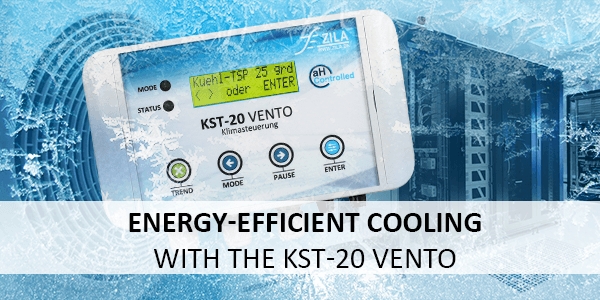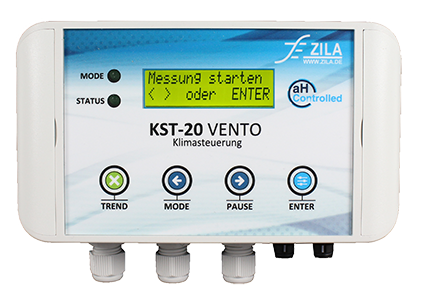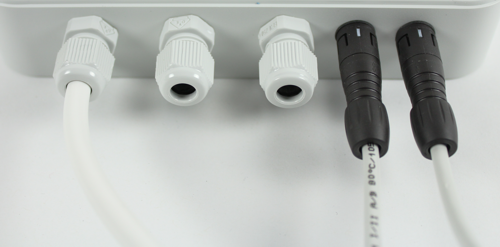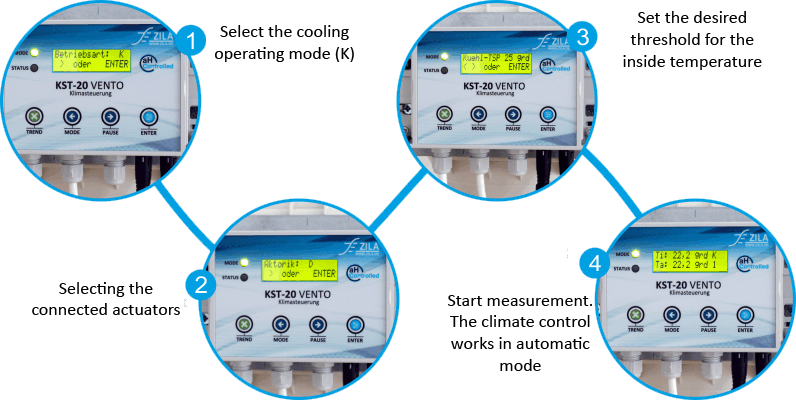
- Written by ZILA GmbH
- font size decrease font size increase font size
Energy-efficient cooling of electrical rooms with the climate control KST-20 Vento
A more energy-efficient approach is temperature-controlled room cooling with the climate control KST-20 Vento. Equipped with an indoor and an outdoor climate sensor, the control takes the climatic conditions in the room and outside the building into account. There is great potential for savings by comparing the indoor and outdoor temperature because natural room cooling with fans and colder outdoor air is ensured, as long as the climatic conditions are favourable for room cooling.

The climate control KST-20 Vento is a multifunctional system, which can be used for dehumidification, ventilation and cooling of all kinds of rooms. For each operating mode and the intended application, the user can easily and quickly configure specific control parameters with control buttons and a display. Compatibility with all common 230V as well as 0...10V actuators of many manufacturers is provided.
Using two-step or speed-controlled fans, the climate control can automatically differentiate between different ventilation levels and thus use the outside air optimally. If required, the cooling process of rooms can be complemented by additional climate control and cooling units to maintain the set interior temperature threshold. On particularly hot days or whenever cooling from the outside air is not sufficient, these devices are automatically switched on by the climate control system instead of fans. Thanks to this user-independent and needs-based use of fans and climate controls, it is possible to cool the room very energy-efficiently.
Room cooling - advantages of the KST-20 Vento at a glance
- Special operating mode for temperature-dependent cooling of rooms
- Automatic, controlled and need-based room cooling
- Two climate sensors for measuring and comparing the indoor and outdoor temperature
- Energy saving by using the outside air
- Setting the temperature threshold for the interior
- Operating keys and display for a convenient configuration and displaying the measured climate values
- Two connections up to 500W for direct connection of the actuators
- Various actuators can be connected (e.g. one-step, two-step and speed-controlled fans as well as air conditioners, cooling units or ventilation flaps)
More technical data: KST-20 Vento ventilation, dehumidification, cooling
Real-life application: Twice as energy-efficient room cooling
Cooling machine and plant rooms is a requirement in many areas of application. In cooperation with one of our customers, we have implemented cooling a compressor room using fans and ventilation flaps in combination with our climate control KST-20 Vento. But instead of releasing the warm air of the compressor room into the atmosphere, it is, especially in winters, redirected via ventilation flaps to warm up a very cold production hall. This heat recovery is an enormous additional benefit for the customer and thus doubles the potential for energy savings*.
You are not sure whether the climate control KST-20 is applicable for your concepts and ideas? Let us find out together! Ask us your questions! We will be pleased to advise you - free of charge and without any obligation.
Product page: KST-20 Vento: Ventilation, Dehumidificatio, Cooling
Sales and consulting: +49 3681 86730 20
Contact form: Open the contact and enquiry form
Configuration and control behaviour of the KST-20 for room cooling

The climate control KST-20 Vento has 5 connection sockets at the bottom of the housing. There are two housing screw connections for the actuators between the power supply on the left and the connections for the two climate sensors on the right. These connections can be loaded up to 500 W and connected with terminals in the housing.
The climate control can be configured in 3 simple steps:

Press the ENTER key to open the configuration menu. Use the right arrow key to select the menu item 'Operating mode' (1). Press ENTER to confirm the selection 'K' for cooling and set the connected actuators (2) in the same way in the following menu. The indoor temperature threshold 'Cooling TSP' (3) can be set between 20°C and 30°C in one-degree steps.
When you exit the menu, the climate control switches to automatic operating mode and indicates the temperatures currently measured for inside and outside.
If the indoor temperature threshold is exceeded and natural ventilation contributes to room cooling, the climate control activates the connected actuators until the temperature in the room is under the indoor temperature threshold again. Supporting actuators such as refrigeration units are only switched on if natural room cooling is not possible and the indoor temperature threshold is exceeded.
|
Speed controlled fans |
One-step fans |
Two-step fans |
 |
 |
 |
|
The graphs illustrate the control behaviour of the climate control over time. For further information, please see the mounting and operating instructions. |
||
Sales and consulting: +49 3681 86730 20
Email: This email address is being protected from spambots. You need JavaScript enabled to view it.
Contact form: Contact and enquiry form
Buy the climate control KST-20 Vento from ZILA!*Concerns about the room air quality? We also offer cabon dioxide sensors and switches depending on the CO2 concentration. More information about CO2 detection
